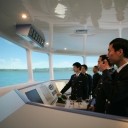Moorings & Passing Traffic
--------------------------------
Own ship moored
In some cases, the vessel will moor at berths where passing traffic might cause the vessel to surge on the berth. In general this will be at berths up rivers or canals. Even vessels passing slowly can cause your ship to surge, which puts a lot of strain on our moorings. Our moorings will stretch some 10% at 50% of their breaking strain. A new rope might well stretch more. Stretched ropes do not readily return to their original length. It is, therefore, essential that they are re-tightened as soon as possible after going slack following a ship passing. If, needed, extra crew must be called out to assist. Once the lines are slack, they are very vulnerable to being parted by a second passing ship as there is nothing at all to control the surge.
Where a danger is known to exist, we will endeavor to increase our springs, head and stern lines. We will also consider having extra crew on stand-by when large vessels are due to pass (for example, at certain berths on Sabine River).
Signal flags ‘R’ over ‘Y’ are the international signal ‘Please pass my vessel slowly’. We should have these hoisted on the OUTBOARD side DAY and NIGHT whenever situation warrants it. At night these flags should still be visible to any passing ship due to ship and Terminal lighting. The meaning of ‘RY’ should be understood by other vessels (at least the Pilot and the Captain should know the signal if not the OOW). Even if they ignore the signal, they cannot say afterwards that we had not tried to warn them of the danger! We must record the names of all passing ships and note if we feel their speed is excessive.
Other ships moored
When passing close to moored ships we should be proceeding at a moderate speed. This will be consistent with our draft at the time. We will be likely to cause more problems for other ships when we are deep laden compared to when we are light. A good Pilot will be aware of the danger and should not need any intervention from the Master or OOW. It is up to us to query with the Pilot if we feel we are going to pass too fast. We must always check on the mooring status of ships as we approach them. Take note if their lines are slack. Record the ship’s name, the time of passing and our log speed. Check to see if any ships or barges are flying ‘RY’. Warn the Master and Pilot if you see this signal being flown.
-------------------------------
This Bridge Memo is developed through more than 15 years by some very experienced ship's masters.It is mainly based on Capt. Inn Davis's rules from ESM (Canada) Ltd.I collect them only for my personally study reason; and for easy reference purpose.
Here, I, as an officer under some instruction of Capt Davis, give my full respects and thankful to Capt. Davis.
-----------------------------------------------------
2nd Officer
Ever-student from Dalian Maritime University
Be proud of DMU
请登录后发帖

 联系我们人工客服
联系我们人工客服



















 :1391995811
:1391995811

